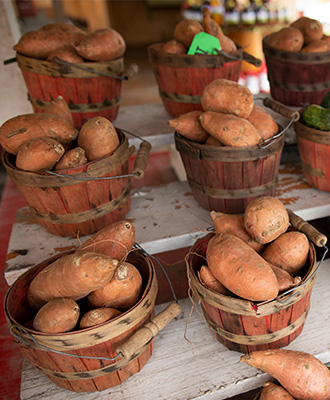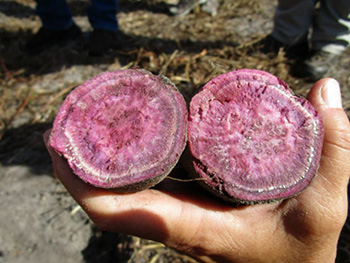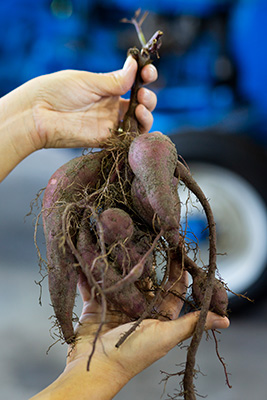Sweet Potatoes
Patient gardeners will be sweetly rewarded.

Originally from Central and South America, sweet potatoes (Ipomoea batatas) are known for their colorful and tasty tubers. The flesh is generally orange but certain cultivars come in white, yellow or purple. They’re an excellent source of calcium, potassium and vitamins A and C. The purple-fleshed tubers even contain anthocyanins, which provide many antioxidant health benefits.
Sweet potato is a groundcover or vine perfect for garden beds, along walkways or even in containers. This rapidly spreading annual has green, heart-shaped leaves about 6 inches long. Certain cultivars display showy colors with dark purple, gray or variegated leaves. Sweet potato is in the Convolvulaceae (morning glory) family, and occasionally produce pinkish, funnel-like flowers. The vines can extend up to 15 feet in length, depending on the variety, and about 12 inches in height when situated on the ground. It has a twining growth pattern when allowed to climb but needs training.
Sweet potato’s edible tuberous roots are widely cultivated for their sweet flavor and nutritious nature. They can be baked, mashed or fried, and are often used in casseroles, soups or pies. Not only can you eat the delicious tubers, but the leaves are edible as well. Also nutritious, the young leaves and shoots can provide you with a source of tender and mild-tasting leafy greens throughout the hot Florida summer.
One type of sweet potato is so different, it goes by a different name. The boniato (Ipomoea batatas) is also called the tropical sweet potato and is very popular in Cuban cuisine. You can distinguish boniato from other potatoes by its pink to burgundy-colored skin and creamy white flesh. In terms of taste, boniato is much fluffier, drier and less sweet than the orange-fleshed sweet potato.
Planting and Care
Sweet potato is warm-season crop in Florida and thrives in hardiness zones 9a through 11b. It can be planted in the spring (anytime after the threat of frost) through the end of June.

Photo: Dr. Wendy Mussoline, UF/IFAS.
Sweet potatoes are typically started from transplants called “slips.” Slips are vine cuttings that sprout from a mature sweet potato tuber. While you could grow sweet potatoes slips yourself, it is always a good idea to start out with certified disease-free plants or vine cuttings from a reputable garden supply store. Sweet potato weevils can be a serious problem and starting out with certified-free transplants can help you avoid issues.
Look for transplants that are about 9 to 12 inches long, with at least four nodes (small, bud-like structures that grow on the tubers). Two nodes should be planted beneath the ground surface.
Choose a sunny location—this crop needs direct or partial sunlight to be happy. It thrives in loam or sandy soils with good drainage and can tolerate wet conditions. Plant your sweet potatoes in rows spaced 36 inches apart with 12 to 14 inches between each plant.
This vine does best when it receives a consistent supply of water upon the first four to six weeks of establishment. Florida rainfall patterns are typically sufficient to provide adequate moisture once tubers start to grow. However, during excessively dry conditions, the sweet potato tubers can split, or crack, while growing (during the stage of growth 100 to 120 days from planting). Be careful with fertilizer; applying too much can prevent tubers from forming.
You can keep your sweet potatoes going throughout the season by using vine cuttings to create new plants.
Right plant, right place
Nematodes can sometimes be a problem in Florida, so consider having your soil tested before you plant, especially if you’ve had problems in the past. You can also reduce disease and pest problems with a two-year crop rotation. Rotating where you plant can help prevent infestations of pests such as the sweet-potato weevil.
For the tastiest sweet potatoes, always dig up the previous crop and start a new planting. While sweet potatoes can be grown in tropical regions year-round, plants that are left to grow for too long can encourage pest populations. The sweet potato tubers also get tougher as they continue to grow, which is not pleasant for eating.
Pick Florida-friendly varieties
‘Centennial’ and ‘Beauregard’ are two varieties that grow well in Florida gardens. Gardeners with less space should consider ‘Vardaman’, a bush type of sweet potato that’s great for smaller gardens.
Harvesting Your Sweet Potatoes
Sweet potatoes require a long growing season (at least 120 days after planting) but will reward you greatly in the end. While this is a long period, prolonging the growth even more (up to 150 days) can extend the harvest season as needed if climate conditions cooperate.

To help increase their sweetness, place harvested sweet potatoes in a dark, warm room for approximately 10 days before eating. This allows some of the starch in the roots to convert to sugar. The ideal temperature for curing sweet potatoes is roughly 95°F with 90 percent humidity. For some varieties, particularly those that are drier or have purple or white flesh, the tubers can be cured in the ground by simply removing the vines at the crown (the top of the tuber where the stem or vines emerge) and allowing the sweet potatoes to sit for 10 days prior to harvest.
Once your sweet potatoes are done curing, store them in a cool, dry pantry—not the refrigerator! Storing your sweet potatoes at temperatures below 50°F can cause them to have an off flavor, or worse, rot.
Patience will pay off with delicious and healthy sweet potatoes that will be equally at home on the dinner plate as a vegetable side or in a sweet pie served for dessert. And remember, while the word “yam” is sometimes used to describe the sweet potato, a true yam comes from a totally different plant.
For more information on growing sweet potatoes, contact your county Extension office.
Also on Gardening Solutions
More from UF/IFAS
- Florida Plant ID: Sweet Potato
- Florida Vegetable Gardening Guide
- Growing Organic Sweet Potatoes in Hastings–UF/IFAS Blogs Flagler County
- Nematode Management in Sweet Potatoes (including Boniatos)–Ask IFAS
- Sweet potatoes: the nutritious star of the holiday table–UF/IFAS News
- Video “Sweet Potatoes: An Excellent Choice for Florida’s Subtropical Climate”–UF/IFAS Extension Hernando County on YouTube
